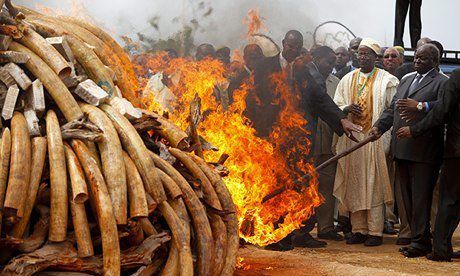BY PASCAL MWANDAMBO
This week the eyes of the conservation world are being trained on Kenya as the government, donor agencies and high profile personalities witness the burning of over 100 tonnes of ivory in Nairobi in what some government and conservation pundits have described as a move meant to “send a message” to poachers, their funders and those trading in ivory and ivory products that the government is committed to deal with the menace that is threatening our wildlife especially jumbos and rhinos with extinction.
A plethora of views have been expressed concerning this exercise, which began way back in 1989 during Moi’s regime and went through Kibaki’s administration and now Uhuru Kenyatta’s government. Throughout these governments, the catch phrase has been to “send a message” to poachers etc etc…
The only difference is that while Moi only set ablaze 12 tonnes of ivory, Uhuru Kenyatta is destroying almost tenfold that amount.
Poaching is both a national and international issue, given that while our country habours the wildlife, most donors funding conservation programmes as well as tourists are from other countries, hence the heated debate the ivory burning saga has elicited.
For many years the elephant and the rhino have been under threat from poachers, who are determined to wipe out these colossi to satiate a burgeoning trade in ivory especially in Asian countries.
However, while many a Kenyan of goodwill would like to see the poaching menace brought to a bare minimum or totally eradicated, the manner in which successive governments have handled the problem leaves a lot to be desired.
While the Jomo government did not destroy and ivory to “send any kind of message” anywhere, reports from history indicate that a close family member had exported ivory even at the time when Jomo’s government had banned export of the same.
It’s this case of double standards that continue to elicit heated debates and raising doubts over the government’s commitment to stamp out the poaching menace and the trade in ivory and ivory products.
It is a well known fact that most influential personalities including politicians and businesspeople don ivory jewellery and also adorn their palatial homes with items made of ivory.
Isn’t it ironical that when retired president Moi was setting on fire tonnes of ivory way back in 1989, the baton(or fimbo yak nyayo) that he was holding was made of ivory?
Anyway, that is water under the bridge. Moving forward, it would have been of great conservation value if conservationists or state agencies could produce empirical data showing that the number of elephants killed by poachers went down by certain margins each time an ivory haul was burnt away.
smoke-screen
Indeed if the government wants to send a message to poachers and their financiers that their illicit trade is doomed to fail, why not make the destruction of ivory more symbolic, say by burning 100 kilos of tusks as cameras roll, so that these images can be beamed around the world, albeit to whip emotions among foreign conservationists and donors?
But 100 tonnes, my foot, not even taking into consideration the environmental impact this exercise is bound to have in the surrounding areas. Why, pray, cant the government store the ivory haul in a strong room to serve as a stark reminder to future generations of the heinous acts of criminals called poachers?
In any case, the ivory haul is a fait accompli and no matter how we pretend to be holier than thou and overzealous about conserving elephants, no amount of crocodile tears , chest-thumping and PR gimmicks will bring the jumbos back to life.
On the one hand sending a message is one thing and finding a solution to a nagging problem is quite another. Methinks it’s imperative that our government ,its conservation partners and donors sobered up and enacted policies and regulations that will eventually kill the ivory trade by denying culprits their booty.
Business is essentially about supply and demand, so as long as there is a market and demand for ivory, eradicating poaching will remain a Herculean task.
Clearly, economic and political goodwill across borders is required between nations hosting wildlife such as rhinos and elephants in their conservancies.
Secondly, a lot needs to be done to combat poaching in vast game reserves such as Tsavo. There have been reports of serious security lapses in the parks, creating a leeway for poachers to kill elephants.
The most grim and glaring case that sent shock waves in the conservation world was the killing of Satao, one of the few surviving patriarchs of over 50 years in Tsavo. Despite being under heavy security, sometimes of over 10 security officers, the old “tusker” was killed by poachers and his tusks weighing over 40 kilos each, spirited away, never to be recovered.
On the other hand, communities living near wildlife conservancies should be empowered through education and financial benefits so that they cease being “spectators” and become “stakeholders” in conservation.
The “Wakio” who lives at Maktau village near Tsavo West needs to be convinced that she can get higher economic benefits from the elephants in the neighborhood than the maize and pigeon peas she grows in her quarter acre piece of arid land.
Unless this happens, communities living near wildlife conservancies will continue to view elephants as a nuisance, a security threat and harbingers of poverty. What of perennial crop destruction, injuries and loss of lives?
To most communities living near wildlife protection areas, elephants are a nuisance, a security threat and harbingers of poverty. What of perennial crop destruction, damage to property, injuries and loss of lives?

/image%2F1675402%2F20170607%2Fob_168a67_in-logo.jpg)




